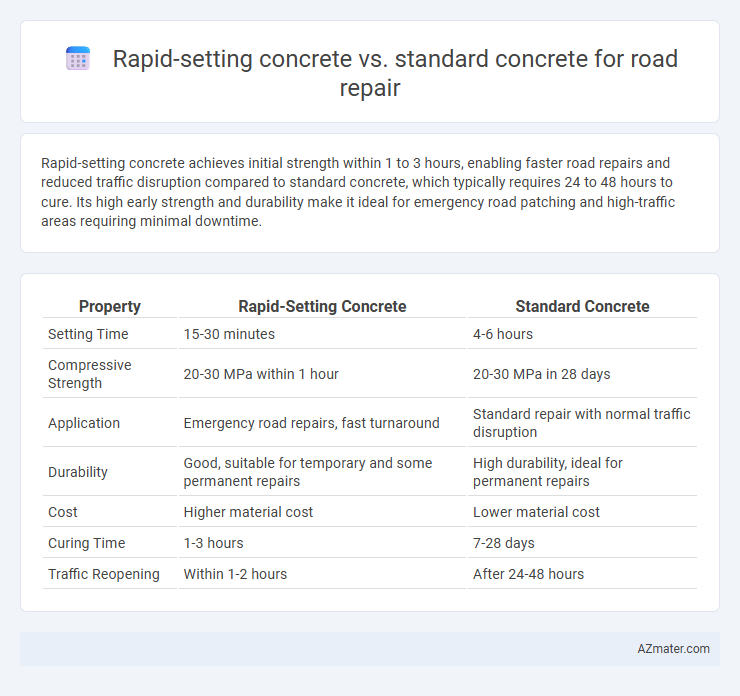Rapid-setting concrete achieves initial strength within 1 to 3 hours, enabling faster road repairs and reduced traffic disruption compared to standard concrete, which typically requires 24 to 48 hours to cure. Its high early strength and durability make it ideal for emergency road patching and high-traffic areas requiring minimal downtime.
Table of Comparison
| Property | Rapid-Setting Concrete | Standard Concrete |
|---|---|---|
| Setting Time | 15-30 minutes | 4-6 hours |
| Compressive Strength | 20-30 MPa within 1 hour | 20-30 MPa in 28 days |
| Application | Emergency road repairs, fast turnaround | Standard repair with normal traffic disruption |
| Durability | Good, suitable for temporary and some permanent repairs | High durability, ideal for permanent repairs |
| Cost | Higher material cost | Lower material cost |
| Curing Time | 1-3 hours | 7-28 days |
| Traffic Reopening | Within 1-2 hours | After 24-48 hours |
Introduction to Rapid-Setting and Standard Concrete
Rapid-setting concrete offers accelerated curing times, typically achieving initial set within 20 to 40 minutes, making it ideal for urgent road repairs requiring minimal downtime. Standard concrete cures more slowly, with initial set times ranging from 2 to 4 hours, providing greater workability for complex projects but extending repair duration. Key components influencing rapid-setting concrete include high early-strength cement and specialized admixtures, whereas standard concrete relies on Portland cement and traditional aggregates for long-term durability.
Key Differences Between Rapid-Setting and Standard Concrete
Rapid-setting concrete achieves initial set within 30 minutes to 2 hours, greatly reducing road closure times, whereas standard concrete typically requires 24 to 48 hours to set and up to 28 days for full curing. Rapid-setting concrete contains specialized accelerators and higher cement content to enhance early strength development, while standard concrete relies on slower hydration processes for long-term durability. The high early strength of rapid-setting concrete enables faster load bearing, making it ideal for urgent road repairs, whereas standard concrete is preferred for projects where curing time is less critical.
Applications in Road Repair Projects
Rapid-setting concrete is ideal for road repair projects requiring minimal downtime and fast reopening to traffic, such as emergency patching and small-scale repairs on busy highways. Standard concrete suits extensive reconstruction tasks and less urgent restorations, offering long-term durability for road surfaces, curbs, and sidewalks. Choosing the appropriate type depends on traffic volume, repair size, and project timeline to ensure optimal performance and safety.
Setting Time and Early Strength Development
Rapid-setting concrete achieves initial set within 30 minutes to 2 hours, enabling faster traffic reopening compared to standard concrete which typically sets in 4 to 6 hours. Early strength development in rapid-setting concrete reaches up to 3,000 psi within 24 hours, significantly higher than standard concrete's approximately 1,000 psi, allowing for quicker load application. This accelerated setting and strength gain make rapid-setting concrete ideal for urgent road repairs requiring minimal downtime.
Durability and Longevity Considerations
Rapid-setting concrete exhibits enhanced durability due to its accelerated hydration process, allowing early strength gain and reducing vulnerability to traffic-induced stress and weathering. Standard concrete, while slower to cure, typically offers long-term structural integrity with proven resistance to cracking and freeze-thaw cycles when properly mixed and maintained. Selecting rapid-setting concrete improves repair turnaround and minimizes road closures but requires precise formulation to ensure comparable longevity to standard concrete in demanding environments.
Cost Comparison and Budget Impacts
Rapid-setting concrete for road repair reduces labor and traffic disruption costs due to its quick curing time, despite a higher initial material price compared to standard concrete. Standard concrete offers lower material expenses but extends project duration, increasing indirect costs such as traffic management and workforce deployment. Budget impacts favor rapid-setting concrete in high-traffic areas by minimizing downtime, while standard concrete suits projects with flexible timelines and tighter upfront budgets.
Installation Process and Labor Requirements
Rapid-setting concrete significantly reduces installation time for road repair by achieving initial set within 30 minutes to 2 hours, enabling faster lane reopenings and minimal traffic disruption. The accelerated curing process requires less labor-intensive handling and fewer protective measures, allowing crews to complete repairs quickly with a smaller workforce. In contrast, standard concrete necessitates longer curing periods, often 24 to 48 hours or more, demanding extended labor presence for finishing, curing, and traffic control.
Traffic Disruption and Road Closure Times
Rapid-setting concrete significantly reduces traffic disruption and road closure times compared to standard concrete due to its faster curing properties, often allowing roads to reopen within 2 to 4 hours. Standard concrete typically requires 24 to 72 hours to achieve sufficient strength for traffic, leading to extended closures and increased congestion. Using rapid-setting concrete for road repair optimizes traffic flow and minimizes economic impact from downtime, making it ideal for high-traffic urban areas.
Sustainability and Environmental Impact
Rapid-setting concrete significantly reduces construction time and traffic disruptions, lowering carbon emissions associated with prolonged equipment idling and vehicle delays. Its enhanced durability minimizes the frequency of repairs and material consumption, contributing to resource conservation and waste reduction. Standard concrete, with longer curing periods, often results in extended environmental disturbances and higher energy use due to repeated maintenance cycles.
Choosing the Right Concrete for Road Repairs
Rapid-setting concrete offers a significant advantage in road repairs with its fast curing time, allowing traffic to resume within hours compared to the several days required for standard concrete to achieve full strength. While standard concrete provides long-term durability and is cost-effective for extensive repairs, rapid-setting concrete minimizes downtime and traffic disruptions for critical or emergency road fixes. Selecting the appropriate concrete depends on project urgency, traffic load, and budget constraints, balancing rapid restoration needs with long-lasting performance.

Infographic: Rapid-setting concrete vs Standard concrete for Road repair
 azmater.com
azmater.com